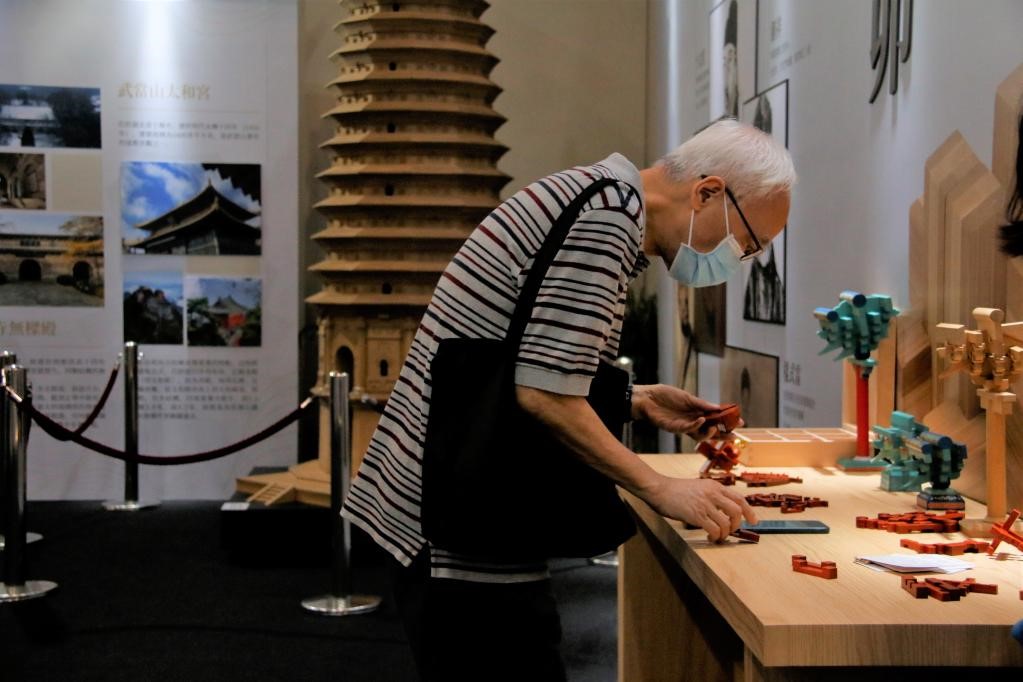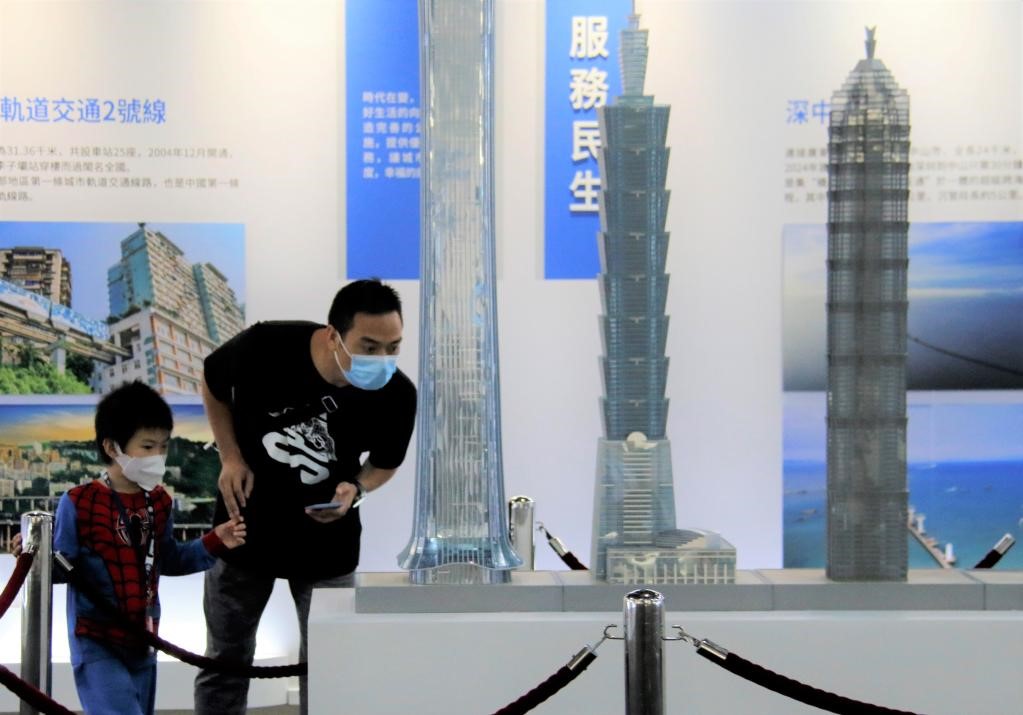Architecture-themed activities held in Hong Kong showcase the region’s development with strong backing from Chinese mainland
A series of architecture-themed activities, including a thematic exhibition on the history of Chinese architecture and the achievements of China’s construction industry and media tours of major projects launched to improve people’s well-being in China’s Hong Kong Special Administrative Region (HKSAR), were held in the region in late October.
When learning about touching stories about projects China has built to improve the well-being of Hong Kong residents during the activities, people from all walks of life in Hong Kong expressed confidence in Hong Kong’s development with the support of the Chinese central government and their sense of pride as members of the Chinese nation in China’s great strides in social and economic development.

Hong Kong residents watch a video about the construction of the Huoshenshan Hospital, a makeshift hospital built for fighting the COVID-19 pandemic in Wuhan, central China’s Hubei province, at the Hong Kong Convention and Exhibition Centre, Oct. 26. (Photo/Xinhua)
They believe that the Chinese mainland always provides the strongest backing for Hong Kong and that the region will certainly embrace a brighter future with the strong support of the Chinese mainland and the central government of China.
Since the beginning of last year, Hong Kong has been struck by four waves of the COVID-19 pandemic. After the third and also the worst wave of the pandemic broke out in July 2020, the region’s public health system was under great strain and its negative pressure rooms almost fully occupied.
At the moment of crisis, Carrie Lam, chief executive of the HKSAR, sought help from the central government of China, which promptly initiated projects to assist the region in building a temporary hospital which was later named North Lantau Hospital Hong Kong Infection Control Centre and a community treatment facility at Hong Kong’s AsiaWorld-Expo (AWE). The municipal government of Shenzhen, south China’s Guangdong province, was in charge of the implementation of the two projects, while construction tasks were undertaken by China State Construction International Holdings Limited (CSCI).
“We had to race against time in advancing the two projects,” said Zhang Yi, general manager of a subsidiary of CSCI that engages in health care services and also the individual chiefly responsible for the construction of the two projects. Zhang shared stories about the construction of the projects at Hong Kong Polytechnic University during one of the architecture-themed activities.
The temporary hospital, which covers an area of 3.2 hectares near the AWE, was designed to provide negative pressure rooms with over 800 beds and other medical facilities, Zhang said.
It was built according to high standards for permanent structure and the construction time was only four months, which posed great challenges to constructors, recalled Zhang, who believes that the delivery of the project on schedule mirrored the strength of China’s construction industry.

A Hong Kong resident makes a model with mortises and tenons at a thematic exhibition on the history of Chinese architecture and the achievements of China’s construction industry at the Hong Kong Convention and Exhibition Centre, Oct. 26. (Photo/Xinhua)
“From the two projects, we felt more strongly that the Chinese mainland has always provided the strongest backing for Hong Kong,” Zhang added.
“I will always remember the experience of participating in the construction of the temporary hospital,” noted Ho Wing Yin, director of the Architectural Services Department of the HKSAR government.
The project has effectively improved Hong Kong’s capabilities to fight the pandemic, she said, adding that the new technologies and methods used during the construction are very important to the development of Hong Kong as they can be applied to the construction of projects concerning people’s well-being in the future.
At the Tseung Kwan O Area 137 in Hong Kong, the construction of a seawater desalination plant phase I project is proceeding in an orderly manner. The project is expected to become Hong Kong’s first seawater desalination plant using reverse osmosis technology, according to Zhang Ming, assistant president of CSCI.
The plant can produce 135,000 cubic meters of freshwater per day, which accounts for 5 percent of Hong Kong’s current fresh water demand, Zhang said.
A project aimed at moving the existing Sha Tin Sewage Treatment Works in Sha Tin district of Hong Kong to caverns in the Turret Hill, which nestles beside the Shing Mun River in Sha Tin district, is being advanced vigorously.
The project has adopted many advanced technologies, pointed out Li Yifeng, manager of the project with CSCI. The arms of an intelligent rock drilling machine are equipped with microsensors, which can significantly improve the accuracy of blasting operation; and a small robot is used as the “vanguard” for probing caves after the blasts, according to Li.
The relocated plant will employ the advanced moving bed biofilm reactor technology, which will not only help solve such problems as bad smell and environmental pollution caused by aging facilities of the old plant, but handle the treatment of sewage for one-tenth of Hong Kong’s population, according to Leung Ka Chung, chief engineer of the Cavern Projects Division of the Drainage Services Department of the HKSAR government.
Fueled by technologies, the new plant will become the largest underground cavern project in Asia upon completion, the official said with pride.

Photo taken on Oct. 26 shows Hong Kong residents watching exhibits at a thematic exhibition on the history of Chinese architecture and the achievements of China’s construction industry at the Hong Kong Convention and Exhibition Centre. (Photo/Xinhua)
CSCI has been deeply involved in the construction of a series of projects in Hong Kong, which cover infrastructure, people’s well-being and residential buildings, according to Chen Cheng, spokesperson of CSCI.
The company will continue putting its strengths to good use to help make Hong Kong people’s life happier and contribute to the long-term stability and prosperity of the region, stressed Chen.
The Hong Kong Palace Museum, which integrates classical and modern styles, is taking shape at the West Kowloon Cultural District of Hong Kong, which, with the Lantau Island located to its west and the Victoria Harbour south, boasts a superior geographical location.
The museum will open to the public around July 2022, which will mark the 25th anniversary of Hong Kong’s return to the motherland, and become another cultural landmark in Hong Kong.
When it opens to the public next year, the Hong Kong Palace Museum will put on display about 900 exhibits from the Palace Museum in Beijing, including 166 first-class cultural relics of China, said Louis Ng Chi-Wa, director of the new museum in Hong Kong.
With the support of the Chinese mainland and a global vision, the Hong Kong Palace Museum will serve as an important platform for spreading Chinese culture, said the director, who noted that the construction of many projects aimed at improving people’s well-being couldn’t have been advanced without the support the Chinese mainland.
Photos
Related Stories
- Hong Kong reports 2 new imported COVID-19 cases
- Hong Kong to comprehensively tighten quarantine exemption arrangements
- Hong Kong's GDP grows by 5.4 pct in Q3: advance estimates
- Exhibition showcasing China’s architectural achievements proves a hit with HK residents
- Hong Kong to expect economic growth of around 6.5 pct in 2021: finance chief
Copyright © 2021 People's Daily Online. All Rights Reserved.










